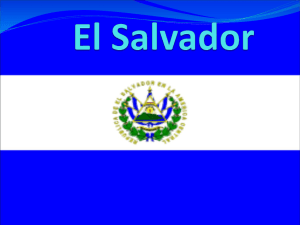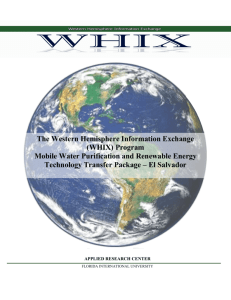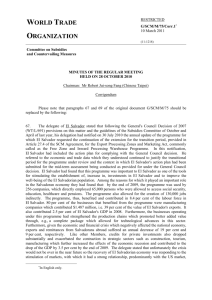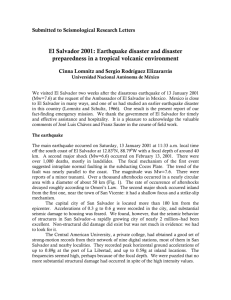VULNERABILITY OF EL SALVADOR
advertisement
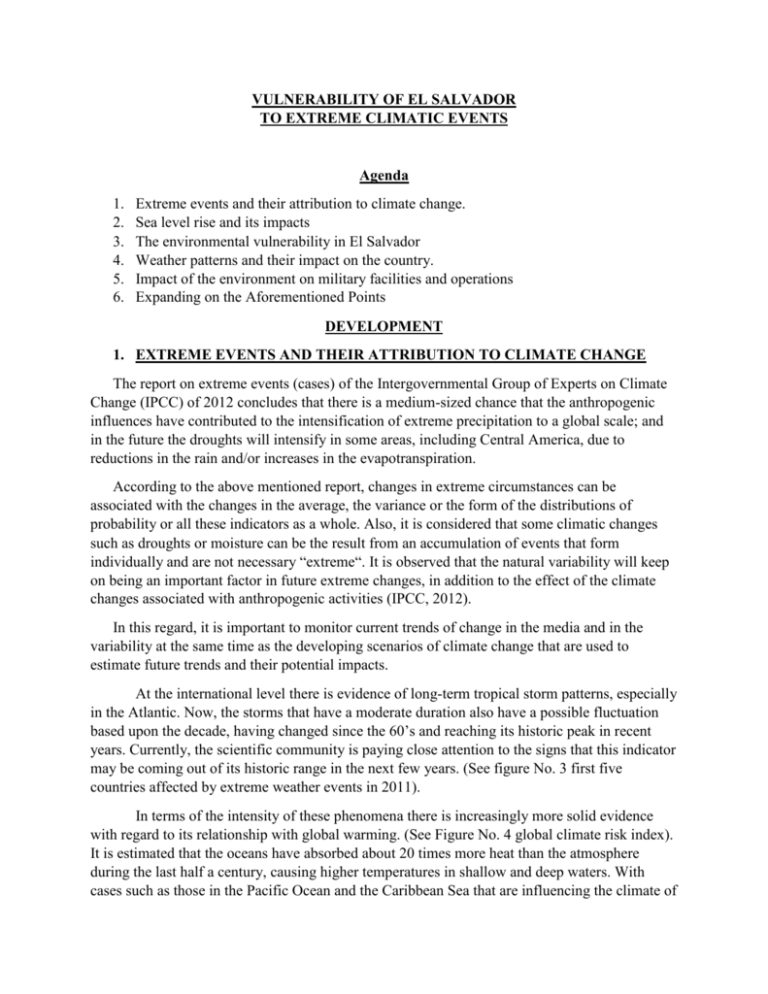
VULNERABILITY OF EL SALVADOR TO EXTREME CLIMATIC EVENTS Agenda 1. 2. 3. 4. 5. 6. Extreme events and their attribution to climate change. Sea level rise and its impacts The environmental vulnerability in El Salvador Weather patterns and their impact on the country. Impact of the environment on military facilities and operations Expanding on the Aforementioned Points DEVELOPMENT 1. EXTREME EVENTS AND THEIR ATTRIBUTION TO CLIMATE CHANGE The report on extreme events (cases) of the Intergovernmental Group of Experts on Climate Change (IPCC) of 2012 concludes that there is a medium-sized chance that the anthropogenic influences have contributed to the intensification of extreme precipitation to a global scale; and in the future the droughts will intensify in some areas, including Central America, due to reductions in the rain and/or increases in the evapotranspiration. According to the above mentioned report, changes in extreme circumstances can be associated with the changes in the average, the variance or the form of the distributions of probability or all these indicators as a whole. Also, it is considered that some climatic changes such as droughts or moisture can be the result from an accumulation of events that form individually and are not necessary “extreme“. It is observed that the natural variability will keep on being an important factor in future extreme changes, in addition to the effect of the climate changes associated with anthropogenic activities (IPCC, 2012). In this regard, it is important to monitor current trends of change in the media and in the variability at the same time as the developing scenarios of climate change that are used to estimate future trends and their potential impacts. At the international level there is evidence of long-term tropical storm patterns, especially in the Atlantic. Now, the storms that have a moderate duration also have a possible fluctuation based upon the decade, having changed since the 60’s and reaching its historic peak in recent years. Currently, the scientific community is paying close attention to the signs that this indicator may be coming out of its historic range in the next few years. (See figure No. 3 first five countries affected by extreme weather events in 2011). In terms of the intensity of these phenomena there is increasingly more solid evidence with regard to its relationship with global warming. (See Figure No. 4 global climate risk index). It is estimated that the oceans have absorbed about 20 times more heat than the atmosphere during the last half a century, causing higher temperatures in shallow and deep waters. With cases such as those in the Pacific Ocean and the Caribbean Sea that are influencing the climate of Central America, its surface temperatures have been rising over the last hundred years. This contributes to the greater intensity of tropical cyclones over the ocean. GERMANWATCH: THE FIRST FIVE COUNTRIES AFFECTED BY EXTREME CLIMATIC EVENTS IN 2011. DEATHS DEATHS BY 100,000 HABITANTS LOSES (MILLIONS OF $ PPP) LOSES (PERCENTAGE OF GDP) Thailand 892 1.39 75,474 12.53 Cambodia 247 1.64 1,049 3.10 Pakistan 585 0.33 5,809 1.19 El Salvador 35 0.69 1,645 3.69 Philippines 1,659 1.73 1,064 0.27 Figure Number 1 first five countries affected by extreme climatic events in 2011 GERMANWATCH OF CENTRAL AMERICA: GLOBAL CLIMATE CHANGE RISK INDEX 2005 2006 2007 2008 2009 2010 2011 El Salvador 34 123 112 91 1 36 Guatemala 1 102 52 34 53 2 Honduras 7 44 33 20 65 5 Nicaragua 21 120 3 24 57 35 Costa Rica 33 128 30 28 111 20 Panamá 65 41 119 30 111 75 Figure Number. 2 Global Climate Change Risk Index 2. SEA LEVEL RISE AND ITS IMPACTS In fact, along the coast of El Salvador there have been significant changes recorded that are associated with climate change (see Figure No. 5 annual average temperature since 1980 until 2000). In recent decades the average sea level rose approximately 7.8 cm, at an average rate of 1.3 mm per year. In regards to the waves, changes have been detected in the average height of waves of 28 cm (4.7 mm per year) with changes in the environment of 0.12 ° N, by year on the mean direction of the wave energy and over 20 cm in extreme wave heights in the last three decades (approximately 2 cm per year). The extreme levels of the sea, also increased by 30 cm in the last six decades, at a rate of 0.5 cm/year. Figure Number. 3 Annual average temperature from 1980 to 2000 3. THE ENVIRONMENTAL VULNERABILITY IN EL SALVADOR Having the highest population density in the hemisphere, after Haiti, and a highly deforested land, El Salvador increases the extent of the impact of extreme climate events, putting at risk almost 90% of the population, 95% of the national territory and 90% of the GDP. With recent scientific studies that prove the increase in the frequency, duration, intensity, and changes in the spatial distribution of climatic phenomena related to changes in the Pacific and Atlantic Ocean systems, it is unfeasible to El Salvador to sustain growth and aspire to an economic development without the adoption of a vision and practice of that adaptation. The vulnerability of El Salvador from the impacts of climate change (see figure No. 1), has an impact on a wide range of areas of life: in the mobility of people, health, production and food security, construction and development of urban spaces and rural settlements, and the physical infrastructure of road connectivity, just to mention a few. Understanding the different types and levels of vulnerability, in terms of its exposure, sensitivity and responsiveness of the Armed Forces and its institutions compared to the changes generated by the climate change is a fundamental and complex task and for the society and the State, which cannot be underestimated. Indicators of Environmental Vulnerability in El Salvador o o o o o Percentage of territory in a risk area Percentage of the population that lives in risk zones Percentage of GDP generates in risk areas Proportion of the territory with high susceptibility to landslides Proportion of the territory susceptible to floods 88.7.7% of the territory 95.4% of the population 96.4% of the GDP 38% 10% (Figure Number 4 Indicators of vulnerability) 4. WEATHER PATTERNS AND THEIR IMPACTS ON THE COUNTRY The location of the narrow isthmus of Central America between two great oceans, the Pacific and Atlantic Oceans, exposes it to the changes that are formed in the weather systems with great impact. For these purposes, there is already ample evidence of climatic variability on various time scales, from intra-seasonal variability through long-term variability. This variability is usually associated with phenomena that already produce impacts of important environmental and socio-economic consequences that can be exacerbated by global warming and associated to climate change. Several researchers in Latin America have identified signals related to variability and/or the change in climatic conditions, particularly rainfall, temperature, oscillations of the glaciers, general circulation and extreme events. Due to the increase in climate variability, the pattern of temporal and spatial rainfall tends to present various anomalies, which affect an increase in disasters linked to hydro-meteorological phenomena (see figure No. 2. Hydrometeorological extreme events between 1960-2010). What is being observed can be summed up as follows: There are more frequent and intense extreme hydro-meteorological events The spatial and temporal distribution of rainfall is much more irregular. There are significant changes in the intensity, trajectory, and number of cyclonic systems originated in the Pacific and Atlantic Oceans that are increasing the intensity in some situations. Temperatures of the ocean waters near Ocean Pacific and Atlantic have become more extreme. Figure Number 5. Extreme Hydro-meteorological events between 1960-2010. MARN Also, between 1961 and 2011 there has been an extraordinary rise in temperature in the surface water of the sea in the oceanic region of the Northern Tropical Atlantic, reaching the highest values recorded over the past 50 years and with this, the of hurricane seasons in that region have been extraordinary in intensity and number. Between the decades of the 1960’s to the 1980’s El Salvador was directly affected by hurricanes and tropical storms; in the 1990’s it was affected by four hurricanes and in the 2000's by seven. In two years, between November 2009 and October 2011 five events took place in which 250 people died. Three of these events produced damages and losses of $1.3 billion (6% of GDP). The flooding of crops and loss of infrastructure, is not the only problem. The drag of soils in the higher parts of the basins accelerates the process of the sedimentation of rivers, natural and artificial drainage, irrigation systems, dams, natural channels of mangroves and finally into the ports on the coast are also associate problems. Recovering and ensuring the country's food security and sustainable agro-livestock production capacity will be an increasingly distant possibility if a response effort is not put in effect to such negative impacts of rainfall and potential drought, by modifying the causes which are known. Already for the year 2008, the MRNA showed that El Salvador had a very drastic lack of tree / vegetable coverage: 42% (170,299 hectares) the total of the areas prone to landslides 67% (23.406 hectares) of the margins of the main rivers (riparian forests) 64% of the main areas of water replenishment (387.630 hectares) 53 % of grounds of high slopes - classes VI and VII (567,296 hectares) 5. IMPACT OF THE ENVIRONMENT ON MILITARY FACILITIES AND OPERATIONS a) Impact of the environment on Military Operations These can affect men, weapons, material and equipment to varying extents but inside military planning climate change should be considered as a threat to the balance between access to energy sources, and supplies. Also consider that there will be a major evacuation of civilians. While the Armed Forces of El Salvador takes it as a safety issue, it also see it as an environmental problem. In this context, "Green" changes made by other armies of the world are stimulated for safety reasons and have nothing to do with concern for the environment or for the people who suffer the impacts of climate change. This takes us back to a specific area of environmental tasks for the armies: for example, requires initiatives to increase the use of alternative fuels in military units with very high oil consumption. The Armed Forces of El Salvador offers assistance to the population when disasters occur, but also helps to reverse the effects of climate change with the establishment and maintenance of forest nurseries in military units, running campaigns of reforestation, donates plants to public and private institutions, it imparts a training environment to the staff on their own to the adaptation and mitigation of the effects of climate change and supports control in the prevention and liquidation of forest fires. It is necessary to take into account two important items to deal with the threat: 1) Training It is necessary to train constantly in efforts to be ready to deal with the extreme weather events, training personnel in all levels to improve the capability of response to assist the affected population by any climate event in our country, taking into account that we are vulnerable to floods, earthquakes, hurricanes and other events. 2) Material and equipment. In order to better support the population, the acquisition of materials and special equipment is needed to be used by the Armed Forces in the search, rescue and evacuation of the affected population, as well as the implementation of green technology. b) Impact of the environment on military installations. Thus far, a direct impact on our facilities caused by an extreme climate event, has not been identified, however some vulnerabilities within the infrastructure which should be reinforced or renovated have been identified.




